Blogging and sharing your passion with the world is fun. And that is a problem because you are not the only blogger in the world. If you want to stand out from the digital crowd, you need to understand where your traffic is coming from and what your visitors are doing. In this article, you will learn how Google Analytics can help you grow as a blogger, or as a business running a blog.
Key Takeaways
- Running a blog without a web analytics tool leaves you in the dark and behind all your competitors. .
- There are 5 dang good reasons for bloggers to opt for Google Analytics (GA).
- Although GA can be overwhelming, there are some handy ways for beginners to understand GA data about blogs quickly.
- In our FAQ at the end of this post, you can find all the answers about how to use GA as a blogger or a business that runs a blog as a marketing tool.
5 excellent reasons to use Google Analytics for your blog
Whether you run a blogging business or use a blog to drive traffic for your business website, Google Analytics is a must-have tool for many reasons.
I have selected the top 5 for you.
1. Google Analytics is free for blogs
Running a blog is an investment. It costs time and or money. Usually, it is the combination of both. Since Google Analytics is a free tool, you can cut down your expenses.
True.
It’s not because it’s free that you need to use it. But the same goes for blogging software or the plugins you are using.
Speaking of which…
2. Access GA data in your blogging CMS
The last version of Google Analytics is not for the faint of heart. To be honest, the learning curve is steep. As a blogger with limited time, this can be scary.
But wasn’t that the case when you published your first blog post too?

Luckily for you, some blogging platforms or plugins can make your life easier in that respect.
Some blogging tools load GA data directly in your CMS dashboard
Google, for example, has its own plugin for WordPress.

If you connect your WordPress blog with your GA account, you will have access to reports everybody, including my cat, can understand.

While all of this is convenient, it is only ideal if you are either new to Google Analytics, or if blogging is a hobby or a small side hustle.
Plugins and platforms that connect your GA account with your blog have limitations. Site Kit, for instance, does not work well with certain caching plugins.
But then again.
Any solution is better than having no data about your blog at all.
3. Google Analytics is the most popular web analytics tool
The fact that GA is the most widely used web analytics tool makes it the best documented one.
You can literally spend years reading, watching, learning GA on forums, blogs and YouTube, such as our own Data Driven channel.

Unless you're like me, you want to blog instead of learning all the ins and outs of a web analytics tool.
To help bloggers like you get up and running with Google Analytics, our team has created tons of how-to guides.
One that is for sure handy for serious bloggers is our step-by-step guide to create content groups in Google Analytics. This free PDF will help you understand in no time which topics are the most popular on your blog.
This is also an excellent example of why Google Analytics is important for every blogger.
What your readers love to read may be different from what you love writing about.

But there is more…
4. GA helps you grow your blogging business
Although money generating platforms show you exactly how much revenue your blog generates, these tools do not give you any idea on how you can improve your blog design or content architecture.
Google Analytics fills in the blind spots for both affiliate marketing blogs and Google Adsense
GA data gives you insights about
- where your blog traffic is coming from (social, organic, referral traffic)
- what users are actually doing on your blog
- on which outbound links visitors click (affiliate marketing)
- how much revenue you make with Google Adsense
Further below, I will show you how you can find this sort of vital data about your blog in Google Analytics.
5. Using GA as data hub for your blog
Running a successful blog takes more than publishing content and praying people will find it. It also involves email marketing, social media, guest posting, link building, keyword research, etc.
Unless you have a team keeping an eye on all your stats, it’s easy to lose track, focus, and time.
Google Analytics can do what no other web analytics tool can do for your blog. You can connect all the dots and look much further than what is happening on your blog.
You can, for example
- Connect GA to Adsense.
- Or if organic search is your thing, to Google Search Console.
If these are not 5 excellent reasons to connect your blog to Google Analytics, I will give you one more.
It’s easy to set it up…
How to get started with Google Analytics as a blogger?
If you haven’t installed Google Analytics on your blog yet, these are the steps you need to follow:
Step 1: Create a Google Analytics account
Head over to the Google Analytics site and create a free account.
Useful resources if you get stuck:
- You can use GA with or without Gmail.
- Here is a quick introduction and checklist to GA for beginners.
Step 2: Install the GA script on your blog
The best way to install Google Analytics on your blog depends on the platform you use and your technical knowledge.
If you are in doubt, follow the advice of Jeff Sauer, founder of Data Driven U:
Don’t Be a Hero, Use a Plugin!

Some blogging software only requires you to paste the measurement ID of your GA property in a field of your CMS.
This is, e.g., the case for
- Blogger, the blogging platform owned by Google
- Squarespace, which also has its own blog statistics
- Some WordPress plugins
Adding the tagging script to the source code of your blog requires more technical knowledge.
It is also risky because of the GDPR. But if you have no other option, make sure you put the GA tracking code in the right place.
Step 3: Test if GA is working on your blog
Once you have implemented the GA code on your blog, the data rolls in within 1-2 days.
However, you don’t want to waste your time and hope all went well.
Here are two resources to buy peace of mind:
- Use the real time report. It only contains data of the last 30 minutes, so you will have to wait until your reports are populated.
- Check if GA is installed on your blog
Step 4: Configure your GA property
Once GA is installed on your blog, it is recommended that you make sure that you collect clean data.
If you are in a hurry, you can do it later. To save time, use these resources:
- The previously mentioned GA checklist
- Activate enhanced measurement. This way, you will, for instance, be able to see what people are searching for on your blog. I will give more useful examples below.
- Exclude visitor data to your blog from your team, or yourself.
If you have finished these 4 steps, you are ready to dive into the reports to analyze the performance of your amazing blog…
Google Analytics FAQ for bloggers
You don’t need to figure out where and what to look for in your GA account to find data to boost your blog. Instead, browse to the list below.
What is the bounce rate on my blog?
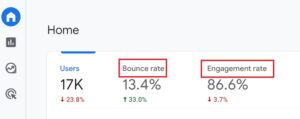
Since Google Analytics 4, the bounce rate is calculated differently than before. It still exists, but a new metric is more useful. It's called engagement rate.
In fact, this is the exact opposite of bounce rate.
So, if you have an engagement rate of 60%, your bounce rate is 40%.
The higher the engagement rate, the more readers like your blog.
It’s a simplification, but as a beginner in GA4, you don’t need to understand all the nuances.
You can find these, and other useful engagement metrics, under Reports > Engagement > Engagement Overview.
How many (returning) visitors does my blog have?
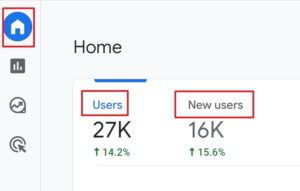
In Google Analytics, visitors or readers are called “users”. You can see how many of them are new and how many of them are returning to your blog.
On the homepage of your GA account, this looks as follows:
Especially active users are important to your blog.
If you are a more advanced GA user, you will also benefit from understanding the different blog audiences in GA4.
Are my blog readers loyal?
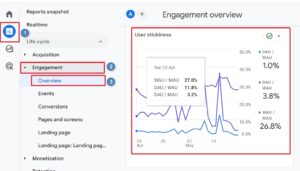
If you have a big blog, or publish regularly, you want to know if you have loyal readers.
Another way than looking at new vs returning users is to look at the so-called stickiness metrics. These are defined as follows:
DAU: daily active users
WAU: weekly active users
MAU: monthly active users
Remember that your blog readers are called users in Google Analytics.
To see this data as an insight card, go to Reports > Engagement > Engagement Overview.
How much time do readers spend on my blog?
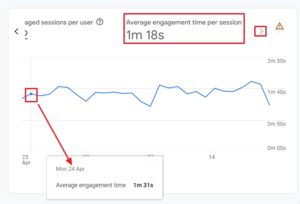
The average time readers spend on your blog is another important KPI to measure your success.
On the homepage of your GA dashboard, you can see the average engagement time.
Note that this is about engaged users, so readers who are actually doing something on your blog. That can be scrolling, or viewing more than 2 pages in one session.
If you go to Reports > Engagement > Engagement Overview, you can see other time related metrics, such as the average time per session on your blog.
What are my most popular blog posts?

Understanding which articles on your blog are most popular will help you understand what your audience wants to see more of. In GA, you can easily find the top 5 most popular blog posts.
Go to Reports >Engagement > Pages and Screens and in the graph, you can see your most visited posts.
A backslash here refers to the homepage of your blog.
In the pages and screens report, you can further analyze every article.
Where do readers enter my blog?
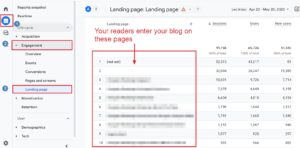
To see on which articles visitors enter your blog, open Google Analytics and go to Reports > Engagement > Landing page.
You will see “not set”. That is because this report is kind of broken. But you can fix it by following the instructions in our article about the GA4 landing page.
How are my YouTube videos performing on my blog?
If you embed YouTube videos on your blog, you can easily track how people are interacting with them. This will give you additional data besides your native YouTube statistics.
To do so, you need to activate in GA4 the automatic tracking of video engagement.
Does my blog have 404 errors?
Blogs are living organisms. The chance that you changed a URL or point to articles that no longer exist is huge.
Although there are dedicated plugins or even online tools that can help you detect 404 errors, you can also find it in Google Analytics.
One of the advantages is that this is one plugin less you need to install and update. Or one site less you have to remember to visit regularly. You can read all the details in our article about detecting page 404 errors in GA.
How much of my blog articles do visitors read?
You can never know for sure how much of your blog posts readers actually read. But you can find out in GA if they scrolled to the end of your posts.
You need to activate one setting. If you want to find out certain pixels, or percentages of page depth scrolling on your blog, that is possible too.
But this requires more technical knowledge. For GA beginners, this is not worth the effort.
Do visitors download files on my blog?
To see which files people downloaded from your blog, all you need to do is activate the tracking of download files in Google Analytics.
it takes less than a minute and the insights you get in return will help you better understand if readers are interested in your files.
You can find all the details in our guide to track downloads in GA.
Which sources drive traffic to my blog?

Knowing where your blog audience is coming from is almost equally important as creating content for them.
In Google Analytics, you can detect which traffic sources result in blog readers by opening the traffic acquisition report.
Go to Reports > Acquisition > Traffic Acquisition.
Depending on where you promote your blog content, you can also find data about visits from social media, email marketing and so on.
For which keywords does my blog rank in Google?
As a blogger, you are probably already familiar with Google Search Console. But did you know that you can link it directly to Google Analytics and see two reports directly in your account?
All you have to do is follow the instructions from this article.
If you are not familiar with either of these tools, you can best read more about the differences between GSC or GA. They will both help you grow your blog into a valuable digital asset.
Although you can track in Google Analytics where people sign up for your newsletter, there is not one way to set this tracking up.
It all depends on how you collect emails for your blog newsletter, or lead magnets:
– embedded forms
– dedicated lead magnet pages
– external plugins that you load on your blog with a script
– pop-ups or slide ins in iframes
How can I track clicks on affiliate links on my blog?
If you run a blog with affiliate links, you can see in Google Analytics how many people click on your outgoing links. A click does not equal a sale with commission, but it can help you improve your design and the locations where you put your links to affiliate partners and programs.
Setting this up is easy if you follow our track clicking guide. You really don’t have an excuse to not do it.
Conclusion: is Google Analytics useful for bloggers?
Yes, because Google Analytics gives you valuable insights about what users do on your blog and how they find it.
And that is only the tip of the data iceberg.
GA can also become your central analytics hub that connects the data from all the marketing efforts you are doing to get traffic to your blog.
Learning GA can take time, but with a plugin you can take a shortcut. It requires less time to understand data that is directly presented in your CMS compared to trying to understand the GA interface.
The sooner you start collecting data about your blog, the better.
When you are ready for it, you can gradually set time aside to learn more about the Google Analytics platform.
This will help you grow your blogging business faster.
What to do next?
If you haven’t installed Google Analytics on your blog, create an account and implement the tracking code ASAP.
Don’t overthink this step. Later on, you can go through this free checklist to make sure you are collecting all the data that is important for you as a blogger.
If you already have GA installed on your blog, you can best set up content grouping.
This will help you to analyze your topics fast. Instead of figuring out how to do this yourself, follow the steps in our free content grouping guide.
Howdy, fellow blogger. On behalf of the Data Driven U team, I thank you for being here instead of writing your next post. Our team hopes this post about Google Analytics for bloggers will help you turn your blog into an epic place.
